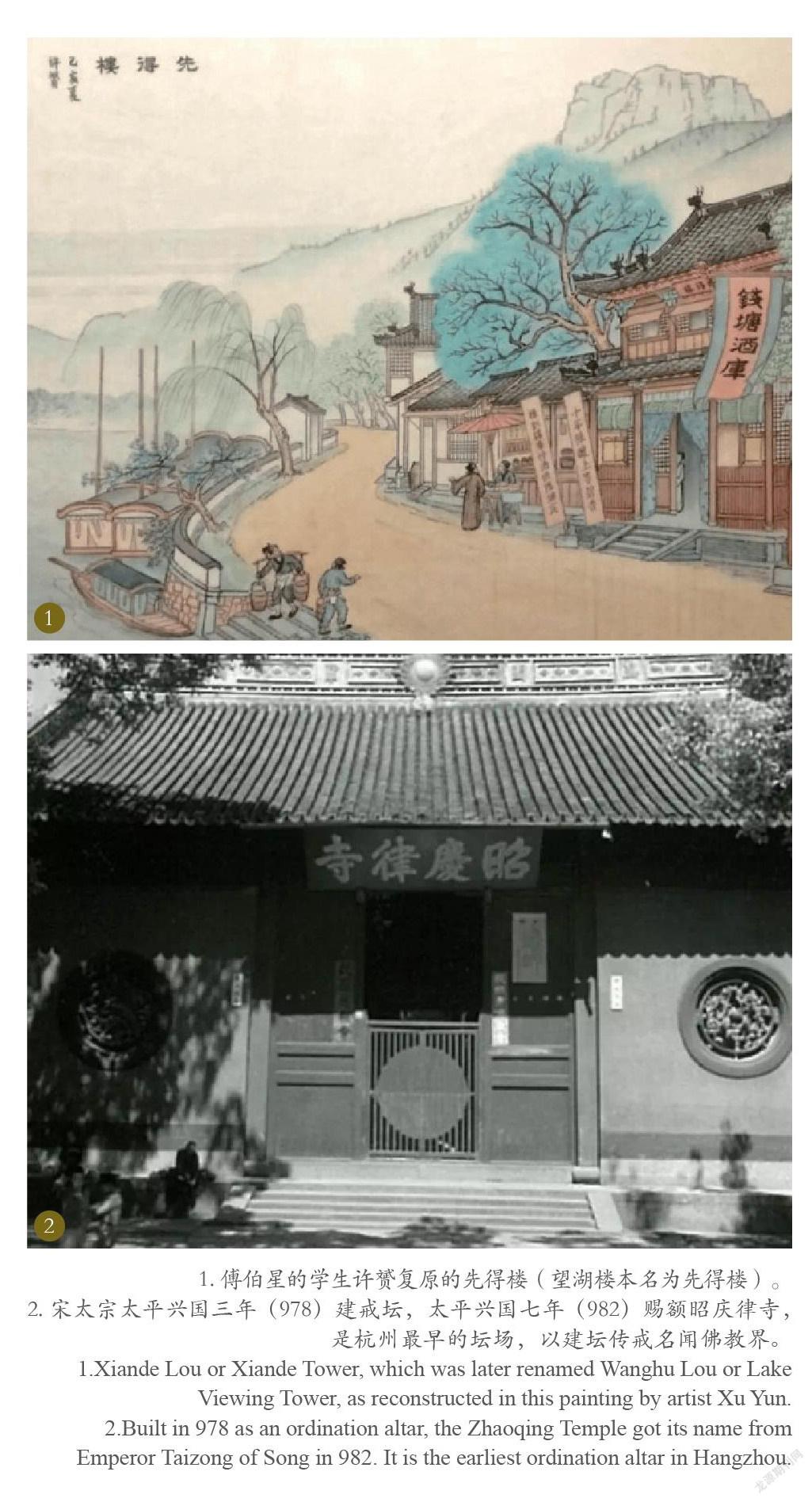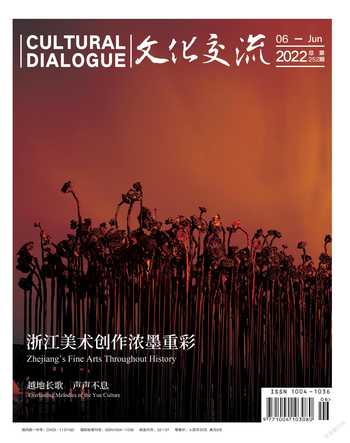望湖楼下水如天
司马一民


外地游客来杭州,断桥是必到之处。距离断桥几百米处的北山路边,宝石山下,有一处绿树掩映、岩峦烘托、飞檐凌空、典雅古朴的楼阁,陪同的人无论是导游还是朋友,都会简单地告诉你,这是望湖楼,苏东坡有一首诗里写的“望湖楼下水如天”,说的就是这里。然后一行人会匆匆而过,向断桥奔去,少有人登楼。
偶尔也有心细的人会问,望湖楼距离西湖湖岸有几十米,怎么会“望湖楼下水如天”呢?
问得好。
望湖楼曾经是杭州西湖的著名景点,原建筑早已不存。现在我们看到的望湖楼是20世纪80年代重建的。
望湖楼原名看经楼,在当时的昭庆寺(现在杭州青少年活动中心)前,始建于乾德五年(967),是吴越王钱弘俶所建,到宋时改名为望湖楼。1926年,西湖边拓建马路,拆掉了昭庆寺的前殿天王殿,万善桥也不复存在了,还填平了桥下的青莲池,但殿前的古樟至今仍存数株。
望湖楼是煮茗把酒、欣赏西湖万种风情的绝佳之处,因此,引来了历代许多文人墨客。其中,最出名的肯定是苏轼了,他的《六月二十七日望湖楼醉书》令望湖楼声名远播:
黑云翻墨未遮山,白雨跳珠乱入船。卷地风来忽吹散,望湖楼下水如天。
这首诗大意为,翻滚的乌云上涌,就如墨汁泼下,却还有山峦未被遮盖。雨滴像白玉珠子一般,落入船里。忽然间狂风卷地而来,满天的乌云被吹散,西湖的碧波与蓝天浑然一体。
熙宁五年(1072)六月二十七日,蘇东坡和友人一起泛舟西湖。六月天气多变,不一会,艳阳高照转为乌云密布,继而风雨大作,船夫赶紧把他们送到近处的望湖楼。他们在望湖楼里边饮酒边欣赏西湖美景。此时,苏东坡不可能不诗兴大发,于是有了《六月二十七日望湖楼醉书》,可惜苏东坡醉书的墨宝没能流传下来。如果流传下来,那会是怎样的一种恣意汪洋啊!
其实,苏轼那天在望湖楼写的《六月二十七日望湖楼醉书》不是一首诗,而是五首诗,最为人们熟知的就是上面这首。
其他四首诗的大意为,鱼鳖虽然已经被放生却还追赶着人们,不知道谁种下的荷花连片盛开,很是壮观。躺在被风吹得晃晃悠悠的游船里,流连忘返。湖里生长的乌菱和白芡不用花钱买,水中的雕胡米(茭白的籽实)就像被包裹在绿盘里。回想起在会灵观品尝新米,漂荡在江海上确实应该多吃一些食物。热情的采莲女采来荷花送给游人,她们头上的翠翘被细雨打湿,仍然不失乡野之美。小洲上长满了香草,也许采莲女并不知道那是《楚辞》里说的香草。我不一定能隐居山林,但想做个闲官暂时还是可以的。我本来就没有家,不安身在这里又能去哪里呢?何况就算我有故乡,那里也没有像这里这样优美的湖光山色。
几乎是同样的季节、同样的情境,元祐四年(1089)七月,苏东坡以龙图阁学士除知杭州军州事,与朋友雨中游西湖,又写下了《与莫同年雨中饮湖上》(莫同年指莫君陈,他与苏轼同为嘉祐二年进士,所以称同年)一诗:
到处相逢是偶然,梦中相对各华颠。还来一醉西湖雨,不见跳珠十五年。
“还来一醉西湖雨,不见跳珠十五年”,苏东坡想起了十几年前泛舟西湖时风雨骤至,想起了当时写《六月二十七日望湖楼醉书》的情景,感慨时光飞逝。
苏东坡是真的喜欢望湖楼,他有一首《临江仙 · 疾愈登望湖楼赠项长官》。项长官,苏东坡同僚。元祐五年(1090)春,苏东坡卧病一月余,病愈后和同僚项长官登上望湖楼赏景,写了这首词赠项长官。
这首词大意为,体弱多病的休文(南朝梁文学家沈约,字休文)。连垂腰的金带都不堪佩系了。花香在望湖楼四处飘散,春风吹拂着我的衣袖,举头仰望,皓月当空,耳边传来悠扬的箫声。酒喝多了酣睡,漏壶的滴水声,惊醒了我的梦。侍酒的美人不见了,自己像月亮独自徘徊在天空般寂寞,如此度过一个良宵也真是太遗憾了。
苏东坡刚刚病愈,身体虚弱,夜晚登上望湖楼,填词抒发心绪的孤寂。
宋人在望湖楼留下的诗篇不少,这里选两首。
北宋李建中(945—1013),字得中,京兆(今陕西西安)人,曾任太常博士等职,写有《杭州望湖楼》:小艇闲撑处,湖天景物微。春波无限绿,白鸟自由飞。落日孤汀远,轻烟古寺稀。时携一壶酒,恋到晚凉归。
南宋林季仲(生卒不详),字懿成,号竹轩,永嘉(今浙江温州)人,写有《登望湖楼》:“胡尘漠漠暗中州,无力持颠漫自忧。花鸟相逢非昔日,不堪重上望湖楼。”
林季仲在宋高宗时为官,反对秦桧和议,做过婺州知州。这首诗写出了诗人登上望湖楼时的沉重心情。也许诗人登上望湖楼参加官方活动时身不由已,虽然眼前湖光山色迷人,但想到了北方大好河山沦落。这首诗与林升的“西湖歌舞几时休”,陆游的“遗民泪尽胡尘里,南望王师又一年”都表达了类似的情感。
The Water Below Looks Like the Sky
By Sima Yimin
For tourists traveling to Hangzhou, the Broken Bridge is a must-visit place. But they seldom go to elegant and ancient pavilion which stands just a few hundred meters away, by the side of the Beishan Road and under the Baoshi Hill. The tour guide would at the most tell the tourists that this is the Wanghu Lou, or the Lake Viewing Tower, and that it was the place where Su Dongpo (aka Su Shi, 1037-1101) left the memorable line “below the Lake Viewing Tower the water looks like the sky”. The tourists would simply acknowledge the fact before proceeding to the Broken Bridge promptly — they rarely ascend the tower.D94A8715-4AD3-479C-A711-AC227A050FCC
Occasionally, some perceptive people would ask, why does “below the Lake Viewing Tower the water look[s] like the sky”, given that the tower is located some 100 meters away from the banks of the West Lake?
A good question.
The Lake Viewing Tower used to be a famous scenic spot around the West Lake, but the original building has long gone. The Lake Viewing Tower we see today is the one that was reconstructed in the 1980s.
First built in 967 by Qian Hongchu (929-988), the last king of the Wuyue Kingdom (907-978), in front of the Zhaoqing Temple (which is now the Hangzhou Youth and Childrens Center), it was originally named the Kanjing Lou (or the Sutra Reading Tower), more than likely because of the Zhaoqing Temple. The temple was once a large complex, with its outer buildings extending all the way to the West Lake. Later, when the Wuyue Kingdom surrendered its territories to the Song dynasty (960-1279), the tower was renamed the Wanghu Lou (Lake Viewing Tower).
In 1926, as more public roads were put in place around the West Lake, part of the Zhaoqing Temple was demolished, and part of the lake in front of the Lake Viewing Tower was also reclaimed, with only a number of ancient camphor trees left behind.
An ideal location to appreciate the varied beauty of the West Lake and have a sip of tea and wine, the Lake Viewing Tower had been a gathering place for prominent literary figures from the very beginning. One of the most well-known must be Su Shi, whose poem Written While Drunken at the Lake Viewing Tower on the 27th Day of the Sixth Month.
Like spilled ink, black clouds have yet covered the mountain;
Like dancing pearls, white rains have chaotically entered the boat.
Rolling around the wind comes, suddenly blowing everything away.
Below the Lake Viewing Tower the water looks like the sky.
On the 27th day of the sixth lunar month in 1072, Su was traveling in a boat on the West Lake with his friends. Before long, the sunny day turned pitch dark and heavy rain ensued. After they returned to the Lake Viewing Tower, Su must have had the urge to compose poems, hence the one above. In fact, it is only one of five pieces that Su wrote on that occasion, albeit the most widely known.
Seventeen years later, in the seventh lunar month of 1089, in the same season and under almost identical weather conditions, Su visited the Lake Viewing Tower — again encountering rain on the West Lake, and wrote a poem, in which he reminisced about the similar scenes in 1072 and lamented the vicissitudes of time.
Whats more certain was Sus genuine fondness for the place. Not a year had passed before he returned to the tower with his friend to enjoy some spring air, although Su had been bedridden for more than a month and just recovered from a major illness.
Apart from Su Shi, Song officials, poets and even hermits wrote about the Lake Viewing Tower, including Li Jianzhong (945-1013), Pan Lang (?-1009) and Lin Jizhong (1088-1150).D94A8715-4AD3-479C-A711-AC227A050FCC

